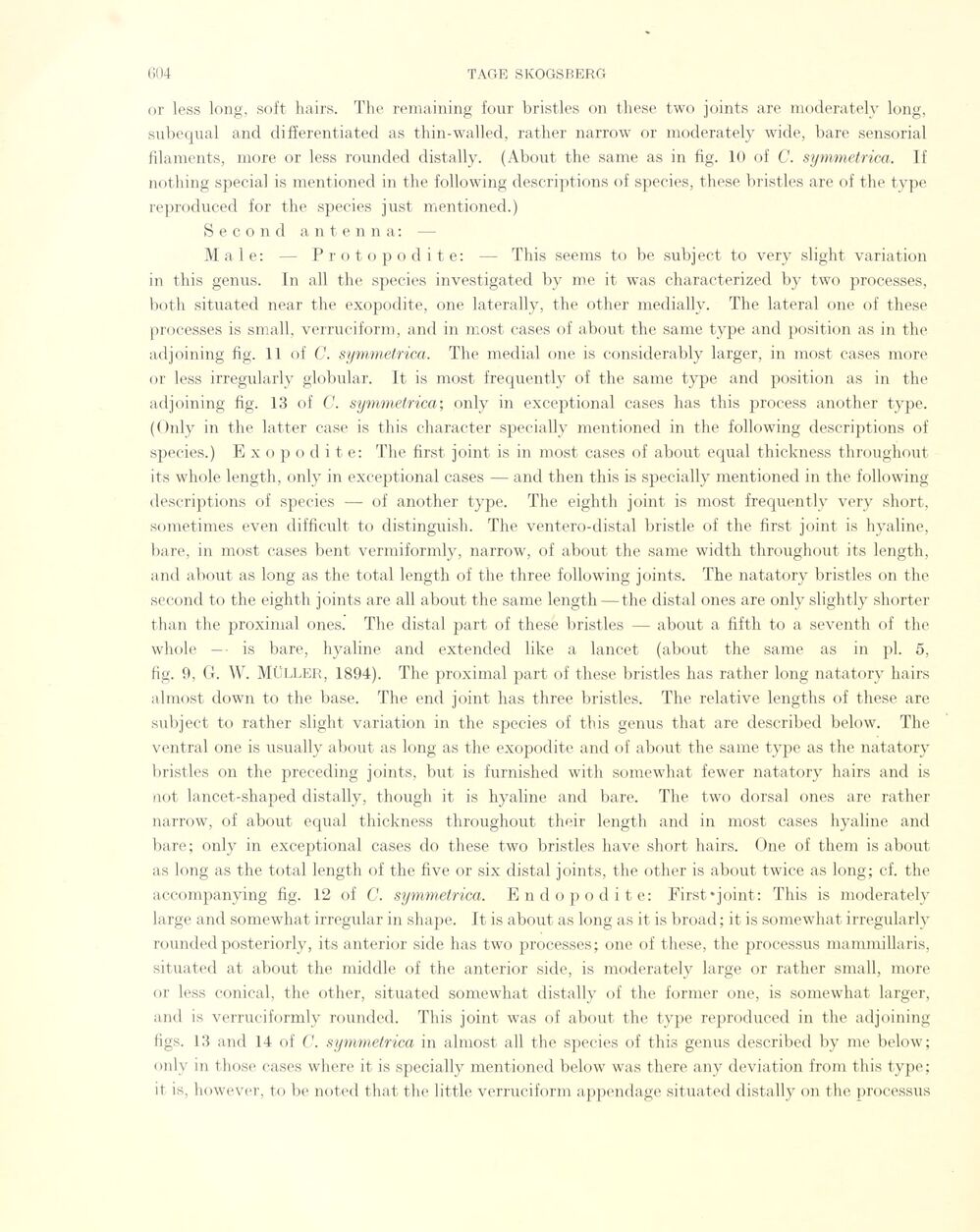
Full resolution (JPEG) - On this page / på denna sida - Sidor ...

<< prev. page << föreg. sida << >> nästa sida >> next page >>
Below is the raw OCR text
from the above scanned image.
Do you see an error? Proofread the page now!
Här nedan syns maskintolkade texten från faksimilbilden ovan.
Ser du något fel? Korrekturläs sidan nu!
This page has never been proofread. / Denna sida har aldrig korrekturlästs.
or less long, soft hairs. The remaining four bristles on these two joints are moderately long,
subequal and diflerentiated as thin-walled, rather narrow or moderately wide, bare sensoria!
filaments, more or less rounded distally. (About the same as in fig. 10 of C. symmetrica. If
nothing special is mentioned in the following descriptions of species, these bristles are of the type
reproduced for the species just mentioned.)
Second antenna: —
Male: — Protopodite: — This seems to be subjeet to very slight variation
in this genus. In all the species investigated by me it was characterized by two processes,
both situated near the exopodite, one laterally, the other medially. The lateral one of these
processes is small, verruciform, and in most cases of about the same type and position as in the
adjoining fig. 11 of C. symmetrica. The medial one is considerably larger, in most cases more
or less irregularly globular. It is most frequently of the same type and position as in the
adjoining fig. 13 of C. symmetrica; only in exceptional cases has this process another type.
(Only in the latter case is this character specially mentioned in the following descriptions of
species.) Exopodite: The first joint is in most cases of about equal thickness throughout
its whole length, only in exceptional cases — and then this is specially mentioned in the following
descriptions of species — of another type. The eighth joint is most frequently very short,
sometimes even difficult to distinguish. The ventero-distal bristle of the first joint is hyaline,
bare, in most cases bent vermiformly, narrow, of about the same widtli throughout its length,
and about as long as the total length of the three following joints. The natatory bristles on the
second to the eighth joints are all about the same length — the distal ones are only slightly shorter
than the proximal ones. The distal part of these bristles — about a fifth to a seventh of the
whole — is bare, hyaline and extended like a lancet (about the same as in pi. 5,
hg. 9, G. W. Müller, 1894). The proximal part of these bristles has rather long natatory hairs
almost down to the base. The end joint has three bristles. The relative lengths of these are
subj eet to rather slight variation in the species of this genus that are described below. The
ventral one is usually about as long as the exopodite and of about the same type as the natatory
bristles on the preceding joints, but is furnished with somewhat fewer natatory hairs and is
not lancet-shaped distally, though it is hyaline and bare. The two dorsal ones are rather
narrow, of about equal thickness throughout their length and in most cases hyaline and
bare; only in exceptional cases do these two bristles have short hairs. One of them is about
as long as the total length of the five or six distal joints, the other is about twice as long; cf. the
accompanying fig. 12 of C. symmetrica. Endopodite: First‘joint: This is moderately
large and somewhat irregulär in shape. It is about as long as it is broad ; it is somewhat irregularly
rounded posteriorly, its anterior side has two processes; one of these, the processus mammillaris,
situated at about the middle of the anterior side, is moderately large or rather small, more
or less conical, the other, situated somewhat distally of the former one, is somewhat larger,
and is verruciformly rounded. This joint was of about the type reproduced in the adjoining
hgs. 13 and 14 of C. symmetrica in almost all the species of this genus described by me below;
only in those cases where it is specially mentioned below was there any deviation from this type;
if is, however, to be noted that the little verruciform appendage situated distally on the processus
<< prev. page << föreg. sida << >> nästa sida >> next page >>